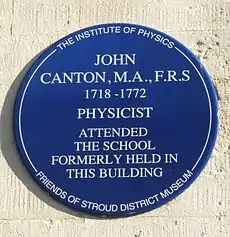John Canton
John Canton FRS (31 July 1718 – 22 March 1772) was a British physicist. He was born in Middle Street Stroud, Gloucestershire, the son of a weaver John Canton (b. 1687) and Esther (née Davis). As a schoolboy, he became the first person to determine the latitude of Stroud, whilst making a sundial.[2] The sundial caught the attention of many, including Dr Henry Miles, a Stroud-born Fellow of the Royal Society. Miles encouraged Canton to leave Gloucestershire to become a trainee teacher for Samuel Watkins, the headmaster of a Nonconformist school in Spital Square, London, with whom he ultimately entered into partnership.

John Canton | |
|---|---|
 John Canton | |
| Born | 31 July 1718 Stroud, Gloucestershire, England |
| Died | 22 March 1772 (aged 53) |
| Citizenship | British |
| Known for | Electrostatic induction Artificial magnets Compressibility of liquids Canton’s phosphorus |
| Awards | Copley Medal (1751), (1764) |
| Scientific career | |
| Fields | Physics |
In 1750 he read a paper before the Royal Society on a method of making artificial magnets, which procured him election as a fellow of the society. In 1751 he was a recipient of the Copley Medal "On account of his communicating to the Society, and exhibiting before them, his curious method of making Artificial Magnets without the use of Natural ones." He was the first in England to verify Benjamin Franklin's hypothesis of the identity of lightning and electricity, and he made several important electrical discoveries.
In 1762 and 1764 he published experiments in refutation of the decision of the Florentine Academy, at that time generally accepted, that water is incompressible.[3][4] In 1768 he described the preparation, by calcining oyster-shell with sulphur, of the phosphorescent material known as Canton's phosphorus.[5] His investigations were carried on without any intermission of his work as a schoolmaster. He died in London aged 53 of dropsy.
He was the recipient of letters from Thomas Bayes, which were then published by the Royal Society.
He is now mainly remembered for his work in electrostatics,[2] particularly the invention of the pith ball electroscope, and his studies in atmospheric electricity.
References
- http://www.britannica.com/EBchecked/topic/93213/John-Canton
- Herbert, K B H (March 1998). "John Canton FRS (1718-72)". Physics Education. 33 (2): 126–131. doi:10.1088/0031-9120/33/2/019. ISSN 0031-9120.
- Canton, John (1761–1762). "Experiments to Prove That Water is Not Incompressible". Philosophical Transactions. 52: 640–643. doi:10.1098/rstl.1761.0105. JSTOR 105681.
- Canton, John (1764). "Experiments and Observations on the Compressibility of Water and Some Other Fluids". Philosophical Transactions. 54: 261–262. doi:10.1098/rstl.1764.0045. JSTOR 105560.
- Canton, John (1768). "An Easy Method of Making a Phosphorus, That Will Imbibe and Emit Light, like the Bolognian Stone". Philosophical Transactions. 58: 337–344. doi:10.1098/rstl.1768.0045. JSTOR 105793.
External links
 Media related to John Canton at Wikimedia Commons
Media related to John Canton at Wikimedia Commons- Works by John Canton at Project Gutenberg
- Works by or about John Canton at Internet Archive
![]() This article incorporates text from a publication now in the public domain: Chisholm, Hugh, ed. (1911). "Canton, John". Encyclopædia Britannica (11th ed.). Cambridge University Press.
This article incorporates text from a publication now in the public domain: Chisholm, Hugh, ed. (1911). "Canton, John". Encyclopædia Britannica (11th ed.). Cambridge University Press.